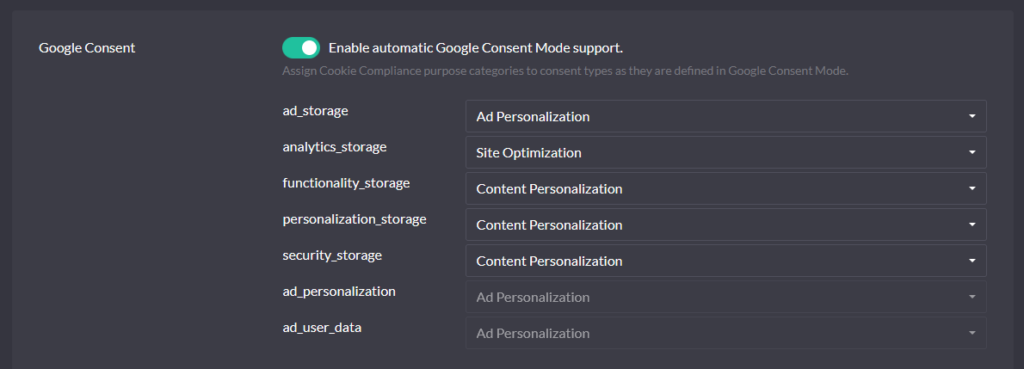Google Consent Mode
Google Consent Mode lets Google tags (Analytics, Ads, Floodlight, etc.) adapt to a visitor’s consent. Cookie Compliance sets a default (before any choice) and then updates Google when the visitor selects an Access Level that enables the relevant Purpose Categories. The result: keeping measurement and advertising aligned with your policy.
What it does in Cookie Compliance terms
While Cookie Compliance expresses consent as Purpose Categories and visitor-friendly Access Levels; Google Consent Mode uses consent types (parameters). The points below show how Cookie Compliance maps your model to Google’s types, and how the banner sets a default on load and updates it after the visitor chooses.
- Default → Update flow. On page load, Cookie Compliance sets a default consent state; when the visitor makes a choice, the banner updates it so Google tags adjust immediately (no reload required). This is how Google intends Consent Mode to be used.
- Consent types. Cookie Compliance drives Google’s parameters:
ad_storage,analytics_storage, plus v2 parametersad_user_dataandad_personalization(controls for storage, ads measurement, and ads personalization). - Access Levels → Purposes → Google (practical mapping).
- Private → Basic Operations only (no Ads/Personalization; Analytics only if your policy permits measurement without identifiers).
- Balanced → Site Optimization allowed; Ad Personalization off.
Personalized → Site Optimization + Content Personalization + Ad Personalization on.
Cookie Compliance maps these choices to the Google consent types at runtime.
- Autoblocking + Consent Mode (complementary). Autoblocking prevents non-essential tags from initializing before consent; Consent Mode ensures that when tags run, Google’s own behavior respects the same consent state.
Implementation in Cookie Compliance
Enable Google Consent Mode in Cookie Compliance. Steps:
- Open Configuration → Consent in the application.
- Toggle on Google Consent Mode.
- Save / Publish your changes.

Implementation in a website
Manual (straightforward)
Enable “Google Consent Mode” in Cookie Compliance
Toggle it in Configuration → Consent. Cookie Compliance will handle the default and update calls behind the scenes
Place Google tags normally — under Cookie Compliance scripts in <head>
This ensures Google receives the default state first, then the update after user action. No edits to the Google snippet are required for the basic integration.
Using Google Tag Manager (GTM)
Don’t call gtag('consent', ...) from a Custom HTML tag—use consent template tags/API or let Cookie Compliance drive it. Use Tag Assistant to verify you see a default then an update.
If you add any consent defaults inside GTM, use the Consent Initialization trigger so those defaults run before any other tags. (Cookie Compliance already sets consent; avoid duplicate/late defaults.)
Google Consent Mode parameters
Google recognizes these parameters and adjusts behavior:
ad_storage– ad cookies/storage.analytics_storage– analytics cookies/storage.ad_user_data– permission to send user data to Google for ads measurement (e.g., enhanced conversions).ad_personalization– permission for personalized advertising/remarketing.
For EEA/UK traffic, Google specifically expects you to pass ad_user_data (ads measurement) and ad_personalization (ads personalization) in addition to the classic storage flags. Cookie Compliance sends these states according to the visitor’s choice.
Verification (quick, practical)
- Tag Assistant / consent debugging. Use Google’s consent debugging guidance to confirm you see a default set before tags load, and an update after interaction. Each parameter you default must be updatable both to “granted” and “denied.”
- GA4 checks. In GA4, link warnings will point out missing ad_user_data or ad_personalization consent for EEA streams; when Cookie Compliance updates consent, these warnings clear as the signals arrive.
Common pitfalls (and fixes)
- Consent defaults too late. If Google tags initialize before consent defaults are set, they may behave as if consent were granted. Make sure Cookie Compliance loads at the top of
<head>and Google tags are placed under it; in GTM, use Consent Initialization for any additional default-setting you do. - Missing v2 parameters. Some setups send only
ad_storage/analytics_storage. Ensuread_user_data(ads measurement) andad_personalization(ads personalization) are part of the state. Cookie Compliance covers these automatically once Consent Mode is enabled. - Conflicting defaults → Avoid setting separate defaults in GTM that compete with Cookie Compliance; use one source of truth and verify with Tag Assistant.
